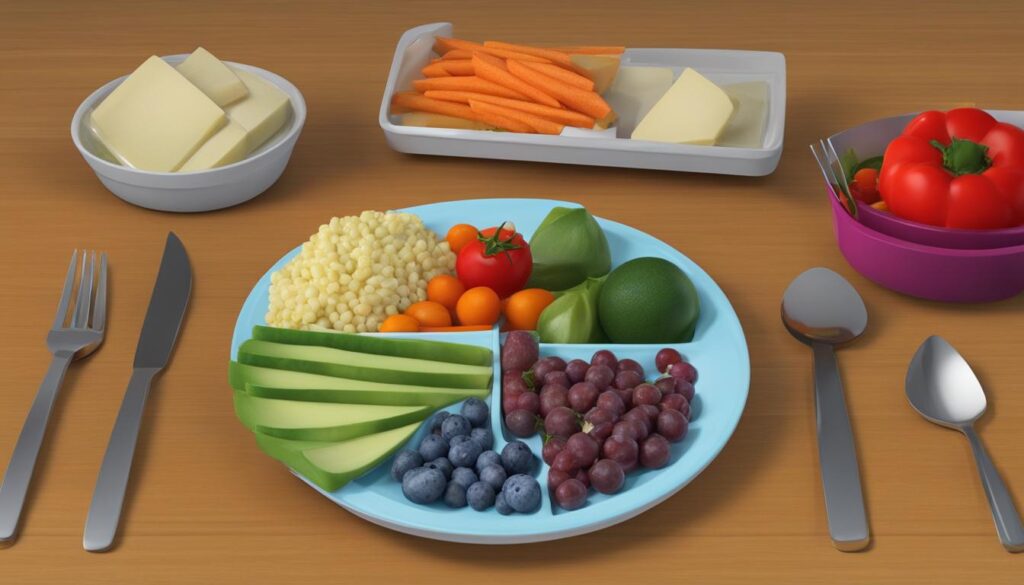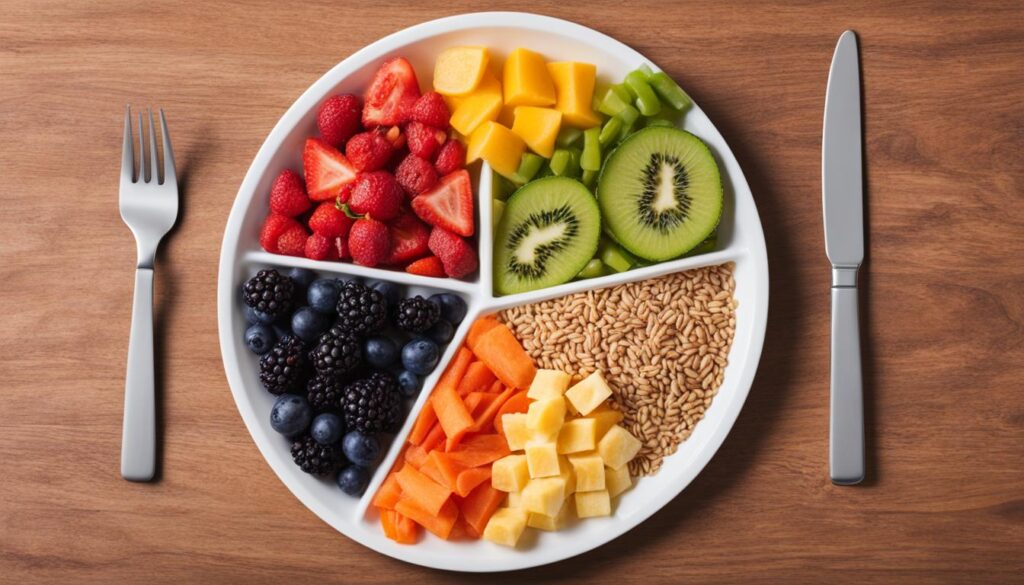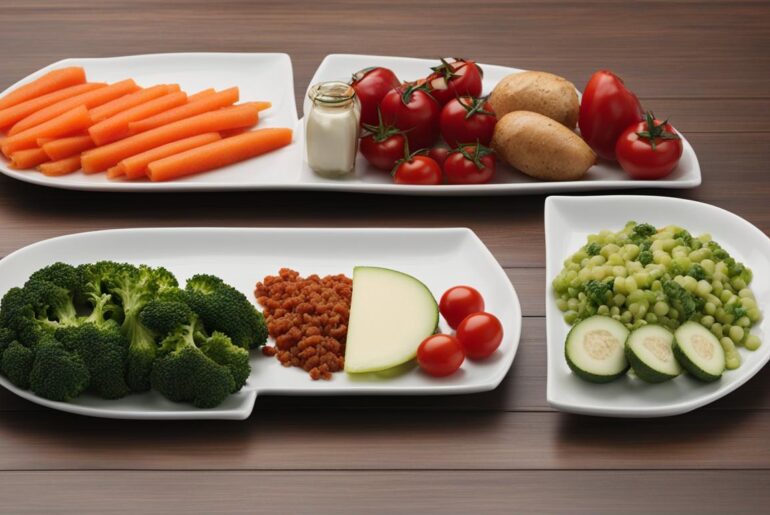Portion control is an essential strategy for avoiding overeating and maintaining a healthy weight. By managing the size of our food portions, we can prevent the consumption of excessive calories and promote mindful eating. Measuring cups, smaller plates, and asking for smaller portions when dining out are effective techniques for portion control.
Additionally, being selective with seconds, avoiding picking at leftovers, and waiting 20 minutes before reaching for a second helping can help prevent overeating. Checking food labels, avoiding double-sized carbs, and using the 20-minute rule are valuable tips for portion control. Implementing these strategies can lead to better portion size management and help us embrace healthier eating habits.
Key Takeaways:
- Portion control helps to avoid overeating and maintain a healthy weight.
- Using measuring cups and smaller plates can aid in portion control.
- Asking for smaller portions when dining out is an effective technique.
- Being selective with seconds and avoiding picking at leftovers can prevent overeating.
- Checking food labels, avoiding double-sized carbs, and using the 20-minute rule are additional tips for portion control.
Tips for Portion Control
When it comes to maintaining healthy eating habits and avoiding excessive food consumption, practicing portion control is key (check out my post on healthy eating habits here). In this section, I will share some effective techniques that can help you master portion control and prevent overeating.
Mindful Eating: One of the most powerful approaches to portion control is practicing mindful eating. This technique involves paying close attention to your hunger and fullness cues, as well as savoring each bite. By tuning into your body’s signals, you can better gauge when you’ve had enough and avoid overeating.
Smaller Dinnerware: Another effective technique is using smaller plates and bowls. By doing so, you create the illusion of a larger serving, which can help satisfy your visual perception while consuming a controlled portion size.
Plate or Hands as Portion Guides: Using your plate or hands as a guide for portion sizes can be a helpful strategy. Dividing your meal into appropriate portions of vegetables, high-quality protein, complex carbs, and high-fat foods ensures a balanced and controlled intake.
Awareness of Serving Sizes: Being aware of suitable serving sizes is crucial for portion control. Familiarize yourself with recommended portion sizes for different food groups and use measuring tools if needed to ensure you’re consuming the right amount.
Avoid Eating from Containers: Eating straight from containers, such as bags or cartons, can lead to mindless eating, making it easier to consume larger portions. Instead, transfer your food onto a plate or bowl to help you better manage your portion sizes.
Pacing Yourself: Finally, pacing yourself during meals is essential. Take your time to chew and savor each bite, allowing your body to register when it’s satisfied. Eating slowly can help prevent overeating and give you a better sense of portion control.
Quote:
“Practicing portion control not only helps manage our calorie intake but also teaches us to be more mindful of our eating habits, leading to a healthier relationship with food.” – Nutritionist Sarah Adams
By incorporating these portion control techniques into your daily routine, you can develop healthier eating habits, avoid excessive food consumption, and maintain a well-balanced diet.
| Portion Control Technique | How It Helps |
|---|---|
| Mindful Eating | Aids in recognizing hunger and fullness cues, prevents overeating |
| Smaller Dinnerware | Creates the illusion of larger servings, promotes portion control |
| Plate or Hands as Portion Guides | Divides meals into appropriate portion sizes, ensures balanced intake |
| Awareness of Serving Sizes | Helps maintain recommended portion sizes for different food groups |
| Avoid Eating from Containers | Prevents mindless eating and consumption of larger portions |
| Pacing Yourself | Allows time for registering satisfaction, prevents overeating |
Portion Control and Weight Management

Portion control plays a crucial role in weight management and the establishment of healthy eating habits. By controlling portion sizes, we can regulate our calorie intake and ensure a well-balanced diet. Research has shown that larger plate sizes and serving utensils can lead to overeating, while using smaller dinnerware can help reduce food intake.
Moreover, being aware of suitable serving sizes and using measuring tools can aid in portion control and prevent the consumption of excessive calories. Practicing portion control consistently can contribute to long-term weight management and the maintenance of a healthy lifestyle.
When it comes to portion control, visual cues are essential. Using smaller plates and bowls can make the food serving appear larger, tricking our minds into feeling satisfied with less. Here’s a table depicting recommended portion sizes for each food group:
| Food Group | Recommended Portion Size |
|---|---|
| Vegetables | Aim for at least 2 cups of non-starchy vegetables |
| Protein | 3-4 ounces (about the size of a deck of cards) |
| Complex Carbohydrates | ½ to 1 cup (about the size of a tennis ball) |
| Healthy Fats | 1-2 tablespoons (about the size of a thumb) |
By following these portion sizes and being mindful of our caloric intake, we can effectively manage our weight and promote healthier eating habits.
Portion Control Tips for Eating Out
Eating out at restaurants can present challenges when it comes to portion control. However, there are strategies that can help us make healthier choices and avoid overindulging.
- Ask for a half portion or a children’s dish: Restaurant servings are often larger than recommended portion sizes. By asking for a smaller portion, we can control our food intake and prevent overeating.
- Share a meal: Sharing a meal with someone not only allows us to enjoy a variety of dishes but also helps in controlling portion sizes. Splitting a main course or ordering appetizers as a group can promote portion control.
- Choose side salad or vegetables: Opting for a side salad or a plate of vegetables instead of a main dish can help us fill up on healthier options while keeping portion sizes in check.
- Avoid buffet-style restaurants: All-you-can-eat buffets can tempt us to overindulge. It’s best to avoid such establishments and opt for restaurants that offer portion-controlled meals.
- Start with a glass of water: Drinking water before a meal can help us feel fuller and reduce the chances of overeating. It’s a simple yet effective way to control portion sizes.
- Take it slow and be mindful: Eating slowly and being mindful of our food choices can help us savor each bite and better gauge our hunger and fullness cues. This can prevent us from overindulging and promote portion control.
By implementing these portion control tips while eating out, we can enjoy a satisfying meal without overindulging and maintain a healthier approach to dining out (check this post out).
The Importance of Portion Control for Preventing Overeating

Overeating is a common habit that can lead to unwanted weight gain and the development of chronic conditions. Portion control is a powerful strategy for preventing overeating and promoting healthier eating habits.
By implementing effective portion control techniques, we can avoid excessive food consumption and embrace a well-balanced lifestyle. Here are some key techniques for managing portion sizes and preventing overeating:
- Using smaller dinnerware and measuring cups
- Being selective with seconds
- Avoiding picking at leftovers
These techniques help us become more mindful of portion sizes and prevent the consumption of excessive calories. By being conscious of our serving sizes, we can better regulate our food intake and avoid overeating.
Additionally, it is important to be mindful of trigger foods that may lead to overeating. It’s not necessary to completely ban all favorite foods, but rather incorporate them in moderation and practice portion control. Incorporating volumetrics, which involves consuming more foods with lower calorie density, can also aid in controlling food intake.
Practicing portion control allows us to enjoy our favorite foods without feeling deprived while maintaining a healthy lifestyle.
The Power of Mindful Eating
One effective technique for portion control is practicing mindful eating. By paying attention to our hunger and fullness cues, we can better gauge our food intake and avoid overeating. Mindful eating involves savoring each bite, engaging all our senses, and appreciating the flavors and textures of the food we consume.
The 20-Minute Rule
Another helpful technique is the 20-minute rule. It takes approximately 20 minutes for our brain to register that we are full. By waiting for this period before reaching for a second helping, we can prevent overeating and give our brain enough time to process the feeling of fullness.
Portion Control at a Glance
| Portion Control Techniques | Benefits |
|---|---|
| Using smaller dinnerware and measuring cups | Aids in regulating food intake and preventing overeating |
| Being selective with seconds | Helps in maintaining appropriate portion sizes and avoiding excessive food consumption |
| Avoiding picking at leftovers | Prevents mindless snacking and controls portion sizes |
By practicing portion control, we can avoid excessive food consumption, maintain a healthy weight, and embrace a well-balanced lifestyle. Portion control is a valuable tool that empowers us to make conscious choices about our food intake and establish healthier eating habits.
Conclusion
Portion control is a crucial element in maintaining a healthy weight and embracing a balanced lifestyle. By implementing effective portion control techniques, such as using smaller dinnerware, being mindful of trigger foods, and practicing volumetrics, we can prevent excessive food consumption and promote healthy eating habits.
One of the main benefits of portion control is that it allows us to enjoy our favorite foods without feeling deprived. By being aware of suitable portion sizes and avoiding distractions during meals, we can develop a better understanding of our hunger and fullness cues. This enables us to make more conscious choices about our food intake and indulge in moderation while still maintaining a healthy diet.
Embracing portion control as a lifelong habit contributes not only to weight management but also to overall well-being. By carefully managing our portion sizes, we can prevent overeating and calibrate our bodies to the correct amount of food needed. This fosters a healthier lifestyle and empowers us to make mindful decisions about what we consume and how much.
In conclusion, portion control has numerous benefits, including weight management, healthy eating habits, and portion size management. By prioritizing portion control and implementing effective strategies, we can achieve better health outcomes and enjoy a well-rounded lifestyle that promotes overall wellness.




